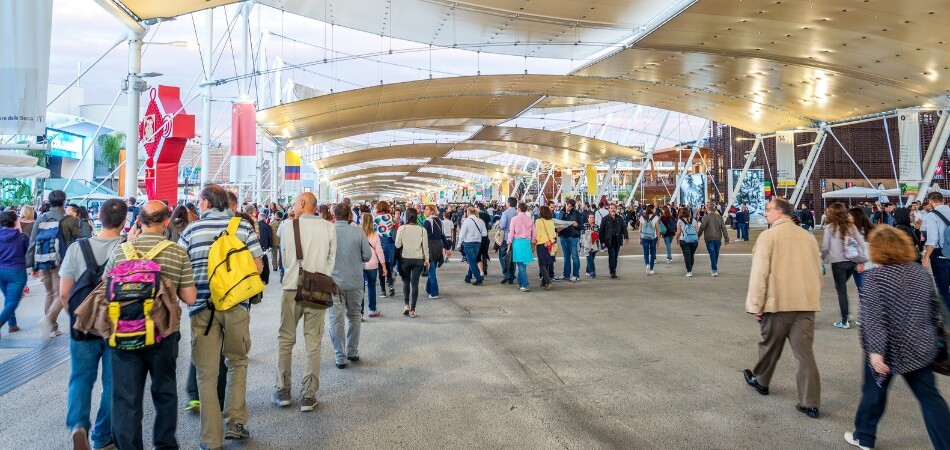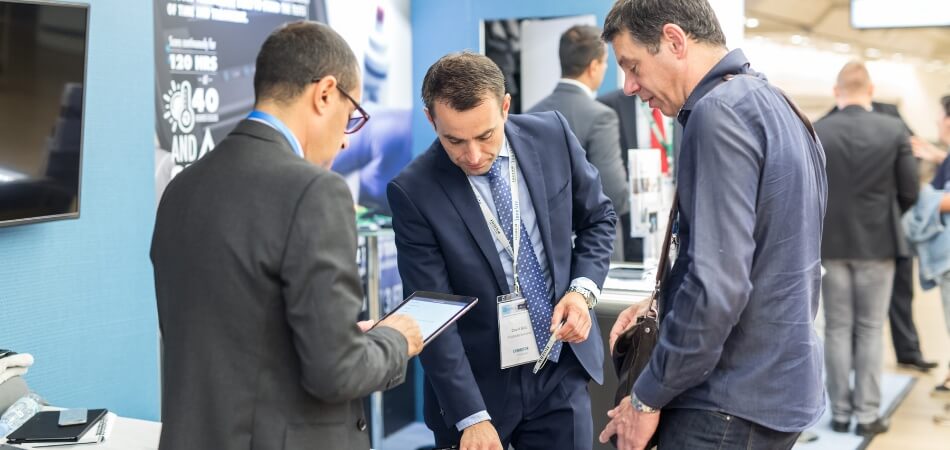Trade shows can be pivotal for businesses, offering a unique opportunity to showcase products, connect with potential clients, and boost brand visibility. Yet, one critical question often leaves exhibitors puzzled: How much product to bring to a trade show?
The amount of product to bring to a trade show typically falls within a range of 1.5 to 3 times your anticipated sales for the event. Factors like booth size and expected foot traffic should be considered for a more precise estimate.
Whether you’re a trade show veteran or a first-timer, planning your product inventory is crucial. In this blog, we’ll explore key factors like booth size, expected foot traffic, and event goals to help you succeed. Join us for valuable insights and practical tips to optimize your trade show booth’s product inventory.
Quick Overview of Trade Show
Trade shows are dynamic events where businesses showcase their products and services to a broad audience. These exhibitions provide a platform for networking, fostering partnerships, and gaining exposure. Exhibitors set up booths to engage with potential clients, share innovations, and create brand awareness.

Participating in a trade show requires careful planning. Companies consider factors like booth design, promotional materials, and product inventory to make a lasting impression. Trade shows offer opportunities to interact face-to-face with prospective customers, allowing businesses to gather valuable leads and insights.
Successful trade show participation hinges on effective marketing, engaging presentations, and a well-prepared team. Companies use these events to launch new products, conduct market research, and strengthen industry relationships. In today’s competitive market, trade shows remain vital for businesses to thrive and expand their reach.
Significance of Trade Shows for Businesses
Trade shows are pivotal for businesses, serving as vibrant platforms for networking, showcasing products, and engaging with the market. Here’s why they matter:
- Exposure Boost: Trade shows offer exposure to a diverse audience, helping businesses gain brand visibility and recognition through face-to-face interactions and product demonstrations.
- Lead Generation: They provide opportunities to generate high-quality leads and build valuable customer relationships, fostering growth by capturing contact information and potential sales.
- Product Launches: Companies can introduce new products and innovations, creating buzz and market interest with live demonstrations and expert presentations.
- Market Insights: Trade shows enable market research, helping businesses stay updated on industry trends and competitor strategies through seminars, workshops, and discussions.
- Networking Hub: These events are a hub for networking, and connecting with industry peers, potential partners, and customers to establish lasting connections and collaborations.
- Competitive Edge: Active participation in trade shows can give businesses a competitive edge by showcasing expertise and credibility through awards, certifications, and expert speaking engagements.
How Much Product to Bring to a Trade Show?
Trade shows are a crucial opportunity for businesses to make an impact and secure valuable leads. Determining how much product to bring to a trade show can be challenging but is essential to maximize your return on investment. Let’s explore the factors that influence this decision.

Booth Size and Layout
The size and layout of your booth play a significant role in product planning. A larger booth allows for more product display space, while a smaller one necessitates careful selection. Consider the flow of foot traffic within your booth and ensure products are easily accessible.
Your booth layout should complement your product’s presentation. If you have limited space, focus on showcasing your most popular or eye-catching items, and consider using digital displays for additional product information.
Expected Foot Traffic
Anticipating the number of attendees is crucial. More foot traffic may require larger product quantities to meet potential demand. Conduct thorough research on the event’s historical attendance and demographics to estimate foot traffic accurately.
Consider offering smaller product samples or giveaways to capture leads while conserving inventory in high-traffic scenarios. For low-traffic events, concentrate on building relationships and making a lasting impression on a select few.
Event Duration and Frequency
The duration of the trade show and its frequency should influence your product inventory. Longer events may require more stock, but be cautious not to overstock for multi-day shows.
For recurring events, analyze past data to determine which products sold well previously and adjust your inventory accordingly. This data-driven approach can help you strike the right balance between supply and demand.
Product Variability and Customization
The nature of your products matters. If you offer a limited product range with little variation, estimating quantities becomes more straightforward. However, if your products come in various sizes, colors, or configurations, plan for a versatile display that accommodates these options.
Consider offering customization options or product bundles tailored to the trade show audience. This can create a unique selling proposition and attract more visitors to your booth.
Goals and Objectives
Your goals for the trade show greatly influence product planning. Are you aiming to sell products directly, generate leads, or raise brand awareness? Align your inventory strategy with your objectives.
If sales are the primary goal, focus on having ample stock and trained staff to process transactions efficiently. For lead generation or brand awareness, prioritize engaging booth activities and product samples to capture visitor interest.
In conclusion, determining how much product to bring to a trade show involves a careful analysis of booth size, expected foot traffic, event duration, product variability, and alignment with your goals. Considering these factors, you can optimize your inventory and enhance your trade show success.
Types of Products You Can Bring to a Trade Show
Trade shows provide a platform to showcase a wide range of products, but choosing the right ones can make a significant difference in your success. Let’s explore the various types of products that are well-suited for trade show exhibitions.
Physical Products
Physical products are a staple at trade shows. These include tangible items such as electronics, apparel, accessories, and consumer goods. Visitors can touch, feel, and experience the products, making them ideal for showcasing innovation and quality.
Technology and Software Solutions
Trade shows are perfect for highlighting technology and software solutions. From software demos to hardware displays, businesses can demonstrate the latest innovations, attracting tech-savvy attendees and potential buyers.
Promotional Merchandise
Promotional items like branded pens, keychains, and tote bags are popular at trade shows. These serve as giveaways and promotional tools to increase brand recognition and engagement with attendees. These items can also have a lasting effect beyond the event, as attendees continue to use them in their daily lives, keeping your brand top-of-mind.
Food and Beverage Products
Edible products like gourmet foods, beverages, or snacks can create a sensory experience at trade shows. Sampling or offering tastings can draw visitors to your booth and leave a lasting impression. Additionally, food and beverage products can serve as conversation starters, allowing you to engage with potential clients while they enjoy a taste of what your company has to offer.
Service Offerings
While not tangible products, service-based businesses can also thrive at trade shows. Consultants, marketing agencies, and other service providers can showcase their expertise and offerings through presentations, consultations, and informative displays.
In conclusion, the type of product you bring to a trade show should align with your goals and target audience. Whether it’s physical products, technology solutions, promotional items, food and beverages, or service offerings, the key is to engage attendees effectively and make a memorable impact.
Common Mistakes to Avoid while Bringing a Product to a Trade show
Participating in a trade show can be a significant investment for your business. To ensure a successful outcome, it’s crucial to avoid common mistakes that can hinder your efforts and impact your return on investment. Here are some key pitfalls to steer clear of:
- Overloading Your Booth: Crowding your booth with excessive products can overwhelm visitors and make your space feel cluttered. Focus on showcasing your best items.
- Neglecting Booth Design: A poorly designed booth can deter potential customers. Invest in an attractive and functional booth layout that draws attendees in.
- Lack of Staff Training: Unprepared staff can miss opportunities. Ensure your team is well-versed in product knowledge and engaging with attendees.
- Ignoring Pre-show Promotion: Failing to market your participation beforehand can lead to low booth traffic. Utilize social media, email, and other channels to generate buzz.
- Not Capturing Leads: Neglecting lead capture means missed potential sales. Have a system in place to collect attendee information for follow-ups.
- Poor Follow-up Strategy: Not following up with leads promptly can result in lost opportunities. Plan a post-show strategy to nurture connections made.
Tips for Effective Product Display at the Trade Show
Creating an impactful product display at a trade show can be the key to attracting potential customers and leaving a lasting impression. Here are some valuable tips to help you showcase your products effectively:

Eye-Catching Visuals
Utilize visually appealing graphics, signage, and banners that not only convey your brand message but also highlight key product features and benefits. High-quality images and clear, concise product descriptions enhance the overall visual appeal, ensuring that attendees can quickly understand your offerings.
Organized Layout
Arrange products in a logical and organized manner within your booth, considering the flow of foot traffic. Group similar items together and ensure that each product has ample space for viewing. A well-organized display not only makes it easier for attendees to explore your products but also enhances the overall aesthetics of your booth.
Interactive Elements
Incorporate interactive elements such as touchscreen displays, live demonstrations, or product samples that allow attendees to engage directly with your products. Hands-on experiences can leave a strong impression, helping potential customers gain a deeper understanding of your offerings and how they can benefit from them.
Lighting Enhancements
Effective lighting can dramatically impact your product display. Use well-placed lighting to not only highlight key products but also create a welcoming and inviting atmosphere in your booth. Ensure that products are well-lit and free from shadows, making them more appealing and enticing to attendees.
Storytelling and Branding
Tell a compelling story about your products and brand through your display. Use storytelling elements like product narratives, customer testimonials, and case studies to connect with attendees on a personal level. Highlighting your brand’s values and mission can also resonate with potential customers, fostering a deeper connection and trust.
In conclusion, a well-executed product display can make a significant difference in your trade show success. By incorporating these additional details into your visual elements, layout, interactivity, lighting, and storytelling, you can create an engaging and memorable experience for trade show attendees, increasing your chances of attracting and converting potential customers.
Conclusion
Trade shows, as dynamic as they are, offer businesses a unique chance to shine and connect. How much product to bring to a trade show? is the initial puzzle piece in this complex trade show experience. These events aren’t just about displaying products; they’re about making connections, gathering insights, and creating a lasting brand presence.
In this vibrant arena, businesses gain the exposure they need to boost brand visibility, generate valuable leads, unveil innovative products, and stay ahead of industry trends. Avoiding common pitfalls and employing effective product display strategies can elevate your trade show success.
So, whether you’re a seasoned trade show veteran or taking your first steps onto the exhibition floor, remember that mastering trade shows is a journey. It’s a journey that can significantly impact your business’s growth, allowing you to make your mark in the bustling world of trade shows.


